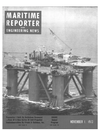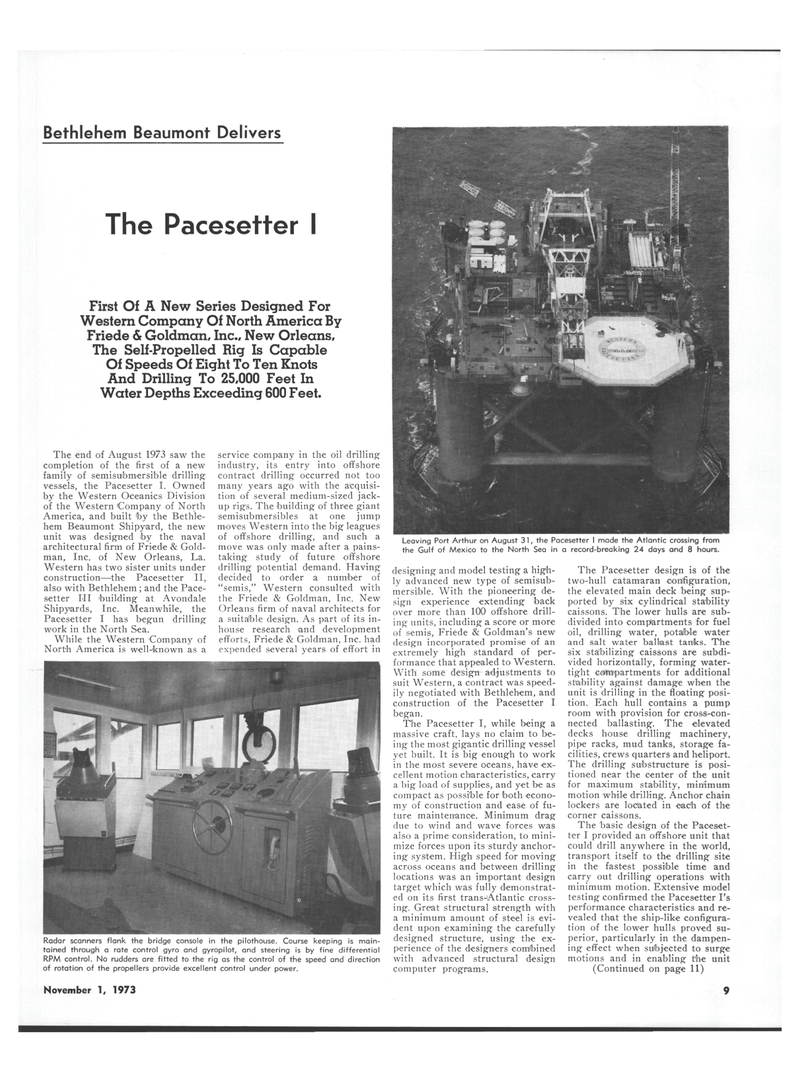
Page 7: of Maritime Reporter Magazine (November 1973)
Read this page in Pdf, Flash or Html5 edition of November 1973 Maritime Reporter Magazine
Bethlehem Beaumont Delivers "he Pacesetter
First Of A New Series Designed For
Western Company Of North America By
Friede & Goldman, Inc., New Orleans,
The Self-Propelled Rig Is Capable
Of Speeds Of Eight To Ten Knots
And Drilling To 25,000 Feet In
Water Depths Exceeding 600 Feet. designing and model testing a high- ly advanced new type of semisub- mersible. With the pioneering de- sign experience extending back over more than 100 offshore drill- ing units, including a score or more of semis, Friede & Goldman's new design incorporated promise of an extremely high standard of per- formance that appealed to Western.
With some design adjustments to suit Western, a contract was speed- ily negotiated with Bethlehem, and construction of the Pacesetter I began.
The Pacesetter I, while being a massive craft, lays no claim to be- ing the most gigantic drilling vessel yet built. It is big enough to work in the most severe oceans, have ex- cellent motion characteristics, carry a big load of supplies, and yet be as compact as possible for both econo- my of construction and ease of fu- ture maintenance. Minimum drag due to wind and wave forces was also a prime consideration, to mini- mize forces upon its sturdy anchor- ing system. High speed for moving across oceans and between drilling locations was an important design target which was fully demonstrat- ed on its first trans-Atlantic cross- ing. Great structural strength with a minimum amount of steel is evi- dent upon examining the carefully designed structure, using the ex- perience of the designers combined with advanced structural design computer programs.
The Pacesetter design is of the two-hull catamaran conifiguration, the elevated main deck being sup- ported by six cylindrical stability caissons. The lower hulls are sub- divided into compartments for fuel oil, drilling water, potable water and salt water ballast tanks. The six stabilizing caissons are subdi- vided horizontally, forming water- tight compartments for additional stability against damage when the unit is drilling in the floating posi- tion. Each hull contains a pump room with provision for cross-con- nected ballasting. The elevated decks house drilling machinery, pipe racks, mud tanks, storage fa- cilities, crews quarters and heliport.
The drilling substructure is posi- tioned near the center of the unit for maximum stability, minimum motion while drilling. Anchor chain lockers are located in each of the corner caissons.
The basic design of the Paceset- ter I provided an offshore unit that could drill anywhere in the world, transport itself to the drilling site in the fastest possible time and carry out drilling operations with minimum motion. Extensive model testing confirmed the Pacesetter I's performance characteristics and re- vealed that the ship-like configura- tion of the lower hulls proved su- perior, particularly in the dampen- ing effect when subjected to surge motions and in enabling the unit (Continued on page 11)
The end of August 1973 saw the completion of the first of a new family of semisubmersible drilling vessels, the Pacesetter I. Owned by the Western Oceanics Division of the Western Company of North
America, and built by the Bethle- hem Beaumont Shipyard, the new unit was designed by the naval architectural firm of Friede & Gold- man, Inc. of New Orleans, La.
Western has two sister units under construction—the Pacesetter II, also with Bethlehem ; and the Pace- setter III building at Avondale
Shipyards, Inc. Meanwhile, the
Pacesetter I has begun drilling work in the North Sea.
While the Western Company of
North America is well-known as a service company in the oil drilling industry, its entry into offshore contract drilling occurred not too many years ago with the acquisi- tion of several medium-sized jack- up rigs. The building of three giant semisubmersibles at one jump moves Western into the big leagues of offshore drilling, and such a move was only made after a pains- taking study of future offshore drilling potential demand. Having decided to order a number of "semis," Western consulted with the Friede & Goldman, Inc. New
Orleans firm of naval architects for a suitable design. As part of its in- house research and development efforts, Friede & Goldman, Inc. had expended several years of effort in
Radar scanners flank the bridge console in the pilothouse. Course keeping is main- tained through a rate control gyro and gyropilot, and steering is by fine differential
RPM control. No rudders are fitted to the rig as the control of the speed and direction of rotation of the propellers provide excellent control under power.
Leaving Port Arthur on August 3 1, the Pacesetter I made the Atlantic crossing from the Gulf of Mexico to the North Sea in a record-breaking 24 days and 8 hours.
November 1, 1973 9

 6
6

 8
8
